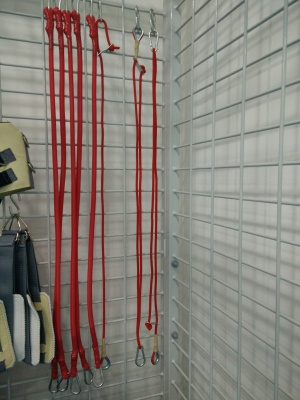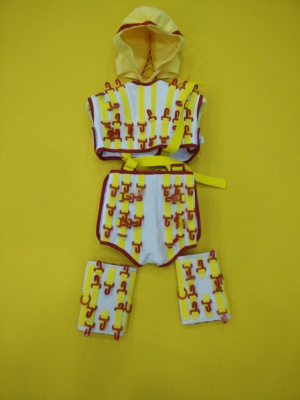Spider Cage: Difference between revisions
(Created page with " Spider Cage {{Search Strategies}}<br> Universal Exercise Unit Google Scholar Cerebral Palsy Thearsuits {{Description}} Spider Cage is a part of universal e...") |
Kim Jackson (talk | contribs) No edit summary |
||
| (37 intermediate revisions by 5 users not shown) | |||
| Line 1: | Line 1: | ||
<div class="editorbox">'''Original Editor '''[[User:Shivali Pandya|Shivali Pandya]] | |||
'''Top Contributors''' - {{Special:Contributors/{{FULLPAGENAME}}}}</div> | |||
== Description == | |||
Spider Cage is a part of universal exercise unit. Spider cage is a suspension system, which works with use of belts, elastic cords and therasuits (therasuits especially for cerebral palsy)<ref name=":0">Afzal F, Gulraiz Q, Manzoor S. [https://d1wqtxts1xzle7.cloudfront.net/55887398/21-2017_omics_int_j_of_phy_med_and_rehab-with-cover-page-v2.pdf?Expires=1634192325&Signature=Y4jCgp-r5zHpcaMRhkUKrgseZF4Al2A-sHOcrY4V6xTnHQAIxK1g9IlrGxhcHLL6pK-av6lo0Zd~IkT0UBPuVyYcwprLFDhUPAB58x9LqJxHNqjJH5EnMs5Q1IV3Hq4ZiBtiPsF-DTT-75z2WWv2P31seN9FJX2GRwlsLz4h3~~VAqGPxM6mpqADX7QQm9bB~qvQMwSKsXOl9jfnwoH63pgNW0EA7LCItleO8132oORnwGB6jotwu36l~MLuCAbuwxvJaD-xEe6dPrzGaY1zgzFEHIhZs9W3pqvbeG-lcK0jnrjGWPal31enGKMNFmQDrR81ebM8nTL3awzhNFEurQ__&Key-Pair-Id=APKAJLOHF5GGSLRBV4ZA Role of Spider Cage in Motor Control in Cerebral Palsy.] Int J Phys Med Rehabil. 2017;5(420):2.</ref>. | |||
The name "'''Spider cage'''" was given by children who were being treated in suspension system with bungee cords. | |||
== Equipment Used == | |||
Equipments that can be used in spider cage are:<br> | |||
[[Image:Bungee Cords.jpg|thumb|right]] | |||
*Bungee Cords: These cords apart from being elastic provides right amount of support to patient and help patient to maintain position independently | |||
*TheraSuit (used especially with patients of cerebral palsy), was designed by Richard and Izabela Koscienlny in 2002 who are physical therapists. | |||
=== Therasuit === | |||
Therasuit consists of following parts: [[Image:Therasuit.jpg|thumb|right]] | |||
*Cap | |||
*Vests | |||
*Shorts | |||
*Knee Pads | |||
*Arm attachments | |||
*Shoe attachments | |||
TheraSuits are available in sizes like extra small, small, medium, large and extra large.<br>TheraSuit can mostly be used for patients with cerebral palsy and neuromuscular disorders. It helps in improving proprioception, reducing pathological reflexes, and promoting proper muscle movements. | |||
== How it works == | |||
Patient is suspended in between the cage with the help of cords and therasuit. Cords are dynamic and provides an appropriate amount of support with the help of which patient can perform movement independently.<ref>TheraSuit method. Intensive Neuro-Functional Strengthening Program. Available from http://www.suittherapy.com/ [last accessed 13/10/2021]</ref> Like this patient can perform many exercises like crawling, standing, jumping in spider cage. Performing these exercises in full or partial weight bearing will allow patient to improve sensory integration, developing sense of security and mastering respective activities.<ref>Richard Koscielny, PT. Importance of strengthening. | January 2010 | Rehab Management. Available from https://revivo.ca/pdf/TheraSuit%20article%20strengthening%202010.pdf [last accessed 13/10/2021]</ref> | |||
Spider cage can be used when a therapist have following goals to work on: | |||
*To increase muscle strength | |||
*To prevent muscle atrophies and contractures | |||
*To increase passive and active ranges of joints | |||
*To improve balance and co-ordination | |||
*To improve muscle flexibility | |||
== Indications == | |||
*Pediatric patients with Cerebral Palsy<ref name=":0" />, Neuromuscular disorders, Down's Syndrome and Developmental Delay | |||
*Cerebrovascular Accident (CVA) | |||
*Head injury | |||
*Musculoskeletal disorders including sports injury, rehabilitation following fractures | |||
*Rheumatoid Arthritis | |||
== Advantages == | |||
*Improves strength and flexibility of muscles | |||
*Improves balance and co-ordination | |||
*Promote active ranges of motion of joints | |||
*Helpful in post traumatic rehabilitation | |||
*Promotes motor learning and motor planing | |||
*Promotes movement with partial or full weight bearing | |||
*Provides sensory integration | |||
*Loading and unloading exercises can be done for joint compression and joint distraction<ref>Emara HA, El-Gohary TM, Al-Johany AA. [https://europepmc.org/article/med/26845668 Effect of body-weight suspension training versus treadmill training on gross motor abilities of children with spastic diplegic cerebral palsy.] European journal of physical and rehabilitation medicine. 2016 Feb 4;52(3):356-63.</ref> | |||
== Further Reading == | |||
*[https://revivo.ca/pdf/HBOT%20THERASUIT%20FOR%20ADULTS.pdf New Therapies for CP and Brain Injured Individuals] (HBOT and TheraSuit Method for Adults with CP; Case Study) | |||
* [https://www.sciencedirect.com/science/article/pii/S1110863011000565 Effect of vibration versus suspension therapy on balance in children with hemiparetic cerebral palsy] | |||
* [https://www.sciencedirect.com/science/journal/11108630 Egyptian Journal of Medical Human Genetics] | |||
== References == | |||
<references /> | |||
[[Category:Occupational Health]] | |||
[[Category:Paediatrics]] | |||
[[Category:Paediatrics - Interventions]] | |||
Latest revision as of 12:32, 14 October 2021
Description[edit | edit source]
Spider Cage is a part of universal exercise unit. Spider cage is a suspension system, which works with use of belts, elastic cords and therasuits (therasuits especially for cerebral palsy)[1].
The name "Spider cage" was given by children who were being treated in suspension system with bungee cords.
Equipment Used[edit | edit source]
Equipments that can be used in spider cage are:
- Bungee Cords: These cords apart from being elastic provides right amount of support to patient and help patient to maintain position independently
- TheraSuit (used especially with patients of cerebral palsy), was designed by Richard and Izabela Koscienlny in 2002 who are physical therapists.
Therasuit[edit | edit source]
Therasuit consists of following parts:
- Cap
- Vests
- Shorts
- Knee Pads
- Arm attachments
- Shoe attachments
TheraSuits are available in sizes like extra small, small, medium, large and extra large.
TheraSuit can mostly be used for patients with cerebral palsy and neuromuscular disorders. It helps in improving proprioception, reducing pathological reflexes, and promoting proper muscle movements.
How it works[edit | edit source]
Patient is suspended in between the cage with the help of cords and therasuit. Cords are dynamic and provides an appropriate amount of support with the help of which patient can perform movement independently.[2] Like this patient can perform many exercises like crawling, standing, jumping in spider cage. Performing these exercises in full or partial weight bearing will allow patient to improve sensory integration, developing sense of security and mastering respective activities.[3]
Spider cage can be used when a therapist have following goals to work on:
- To increase muscle strength
- To prevent muscle atrophies and contractures
- To increase passive and active ranges of joints
- To improve balance and co-ordination
- To improve muscle flexibility
Indications[edit | edit source]
- Pediatric patients with Cerebral Palsy[1], Neuromuscular disorders, Down's Syndrome and Developmental Delay
- Cerebrovascular Accident (CVA)
- Head injury
- Musculoskeletal disorders including sports injury, rehabilitation following fractures
- Rheumatoid Arthritis
Advantages[edit | edit source]
- Improves strength and flexibility of muscles
- Improves balance and co-ordination
- Promote active ranges of motion of joints
- Helpful in post traumatic rehabilitation
- Promotes motor learning and motor planing
- Promotes movement with partial or full weight bearing
- Provides sensory integration
- Loading and unloading exercises can be done for joint compression and joint distraction[4]
Further Reading[edit | edit source]
- New Therapies for CP and Brain Injured Individuals (HBOT and TheraSuit Method for Adults with CP; Case Study)
- Effect of vibration versus suspension therapy on balance in children with hemiparetic cerebral palsy
- Egyptian Journal of Medical Human Genetics
References[edit | edit source]
- ↑ 1.0 1.1 Afzal F, Gulraiz Q, Manzoor S. Role of Spider Cage in Motor Control in Cerebral Palsy. Int J Phys Med Rehabil. 2017;5(420):2.
- ↑ TheraSuit method. Intensive Neuro-Functional Strengthening Program. Available from http://www.suittherapy.com/ [last accessed 13/10/2021]
- ↑ Richard Koscielny, PT. Importance of strengthening. | January 2010 | Rehab Management. Available from https://revivo.ca/pdf/TheraSuit%20article%20strengthening%202010.pdf [last accessed 13/10/2021]
- ↑ Emara HA, El-Gohary TM, Al-Johany AA. Effect of body-weight suspension training versus treadmill training on gross motor abilities of children with spastic diplegic cerebral palsy. European journal of physical and rehabilitation medicine. 2016 Feb 4;52(3):356-63.








